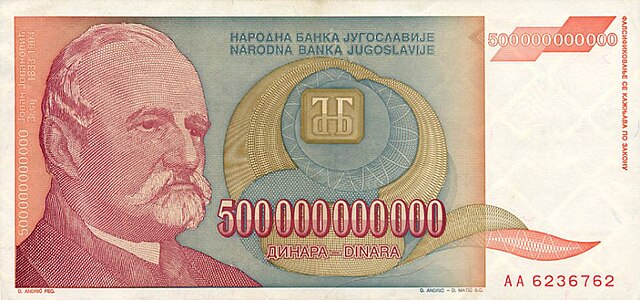The dinar was the currency of Yugoslavia. It was introduced in 1920 in the Kingdom of Serbs, Croats and Slovenes, which was replaced by the Kingdom of Yugoslavia, and then the Socialist Federal Republic of Yugoslavia. The dinar was subdivided into 100 para.
Yugoslav dinar
National Bank of the Kingdom of Serbs, Croats & Slovenes, 10 Dinara (1920). Engraved and printed by the American Bank Note Company, Allegory "Progress" engraved by Robert Savage.
10 million dinara
1 Dinar 1938
Hyperinflation in the Federal Republic of Yugoslavia
Between 1992 and 1994, the Federal Republic of Yugoslavia (FRY) experienced the second-longest period of hyperinflation in world economic history, caused by an explosive growth in the money supply of the Yugoslav economy during the Yugoslav Wars. This period spanned 22 months, from March 1992 to January 1994. Inflation peaked at a monthly rate of 313 million percent in January 1994. Daily inflation was 62%, with an inflation rate of 2.03% in 1 hour being higher than the annual inflation rate of many developed countries. The inflation rate in January 1994, converted to annual levels, reached 116,545,906,563,330 percent (116.546 trillion percent, or 1.16 × 1014 percent). During this period of hyperinflation in FR Yugoslavia, store prices were stated in conditional units – point, which was equal to the German mark. The conversion was made either in German marks or in dinars at the current "black market" exchange rate that often changed several times per day.

A 500 billion dinar banknote, which was the largest denomination banknote printed in Yugoslavia.





